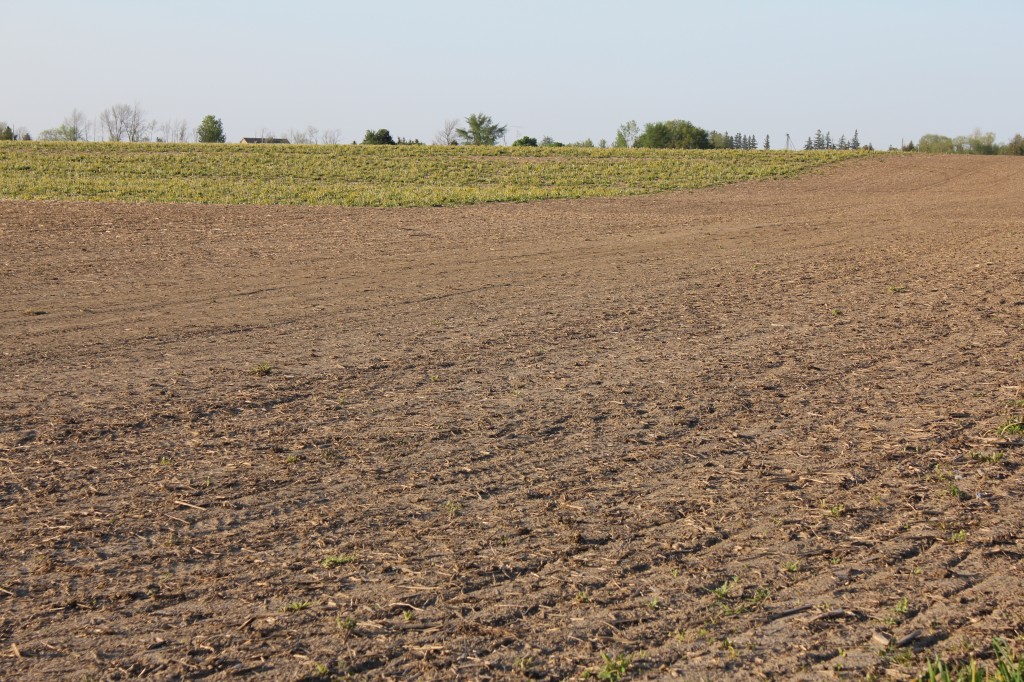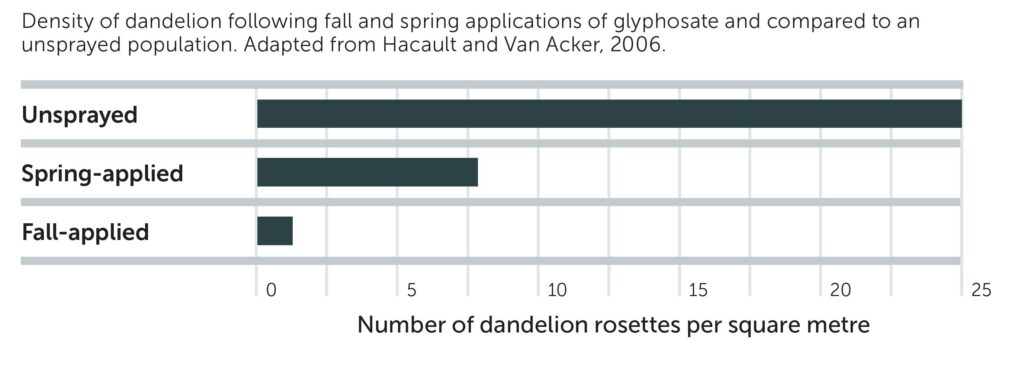The majority of growers, crop consultants and researchers will tell you that it is always better to manage dandelions in the fall then in the spring. Fall management simply is more effective. The photo below clearly illustrates this point. The outside rounds of this field were managed last fall and there is an obvious difference in the level of dandelions within this field in early May.

Best time to control dandelions
Applying herbicides in the fall is more effective at reducing dandelion populations when compared to the spring (Hacault and Van Acker, 2006; Franssen and Kells, 2007). If targeting dandelion in the spring, timing herbicide applications during peak bloom has resulted in the poorest level of weed control while targeting dandelions at either pre or post bloom has been more successful (Raudenbush and Keeley, 2014).

However, if you were unable to control dandelions in the fall, by early May those fields are usually a sea of yellow. And since there is only so much dandelion jam and ice cream one can make, when soybean planting is imminent you want to remove those dandelions as quickly as possible.
Scenario 1: My goal is to have the best control at the end of the season.
If the priority is to maximize the control of established dandelion and have residual control to inhibit germination of seedling dandelions then one of the best treatments for doing so, based on public research trials, is the combination of glyphosate and chlorimuron (e.g. glyphosate + Classic). I cannot stress enough that this is not a fast acting treatment and often takes 2-3 weeks before you start seeing some decent control. Glyphosate (540 g/L) at 1.34 L/ac is also slow but effective at controlling established dandelions. Glyphosate will not inhibit germination of new seedlings. The information below shows a breakdown of all pre-plant herbicide treatments tested in public research trials for the control of dandelion. It is important to note that with the exception of chlorimuron (Classic), all other herbicides tank-mixed with the 0.67 L/ac rate of glyphosate (540 g/L) did not improve the control of dandelion when compared to the 0.67 L/ac rate of glyphosate (540 g/L) on its own. Therefore if you find value in those tank-mix partners for other weed issues, you will need to increase the rate of glyphosate to get adequate dandelion control.
Table 1. Dandelion control at 8 weeks after the application of various pre-plant treatments in soybeans.
| Herbicide | Rate/acre | Avg. Control (8 weeks after app) | Range | Residual Control? |
| glyphosate (540 g/L) | 1.34 L | 90% | 78-97% | No |
| glyphosate (540 g/L) + Classic | 0.67 L + 14.4 g | 89% | 82-96% | Yes |
| glyphosate (540 g/L) | 0.67 L | 79% | 55-95% | No |
| glyphosate (540 g/L) + Eragon LQ + Merge | 0.67 L + 30 mL + 400 mL | 71% | 63-88% | No |
| glyphosate (540 g/L) + Valtera EZ | 0.67 L + 60 mL | 68% | 53-91% | Yes |
| glyphosate (540 g/L) + 2,4-D Ester 700 | 0.67 L + 320 mL | 65% | 60-70% | No |
Scenario 2: The dandelion pressure is horrific! I just want to burn it off as quickly as possible so that I can plant into a semi-decent seedbed.
If you were to walk into any one of these trials at 7-10 days after application certain treatments would stand out, specifically glyphosate tank-mixes that include a group 14 herbicide such as Eragon (saflufenacil) or Valtera (flumioxazin). Herbicides in this particular mode of action will burn leaf tissue very quickly and the results are visually appealing when compared to either glyphosate alone or glyphosate + chlorimuron (Classic, Chaperone). The pictures below were taken yesterday (May 9, 2012) from a comparative trial at the Elora Research Station. However, our experience has been that when dandelion control is evaluated later in the season, the slower acting herbicides ultimately provide better control.


Influence of Tillage
Dandelion is more abundant when tillage is removed in corn and soybean crops while dandelion is abundant in cereals regardless of tillage system used (Swanton et al., 2006). The moldboard plough is the most effective tillage tool at reducing dandelion populations as it is more likely to uproot the entire taproot. A tandem disc can also do a reasonable job on dandelion while a chisel plough is not very effective at controlling dandelion. If the taproot is segmented instead of pulled to the surface, the segments will propagate and produce new plants.
Influence of Cover Crops
The response of dandelion populations to cover crops has varied largely because of differences in tillage systems that occurred within the studies. In a minimum tillage organic bean production system, dandelion was unaffected by the planting of fall seeded cereal rye and barley (Evans et al., 2016). While the introduction of cereal rye in a summer-fallow wheat cropping sequence that used tillage reduced dandelion density (Moyer et al., 2000).



